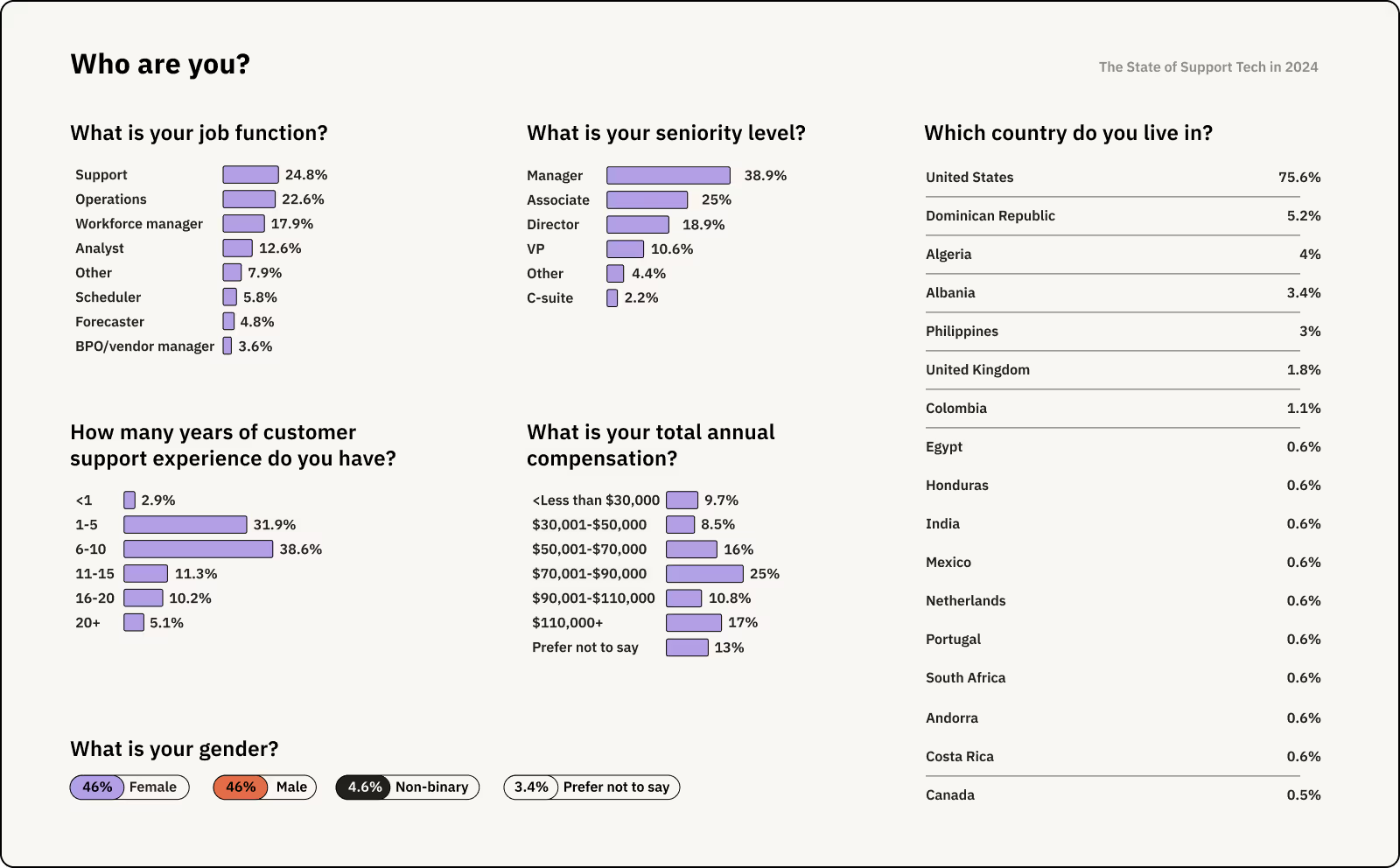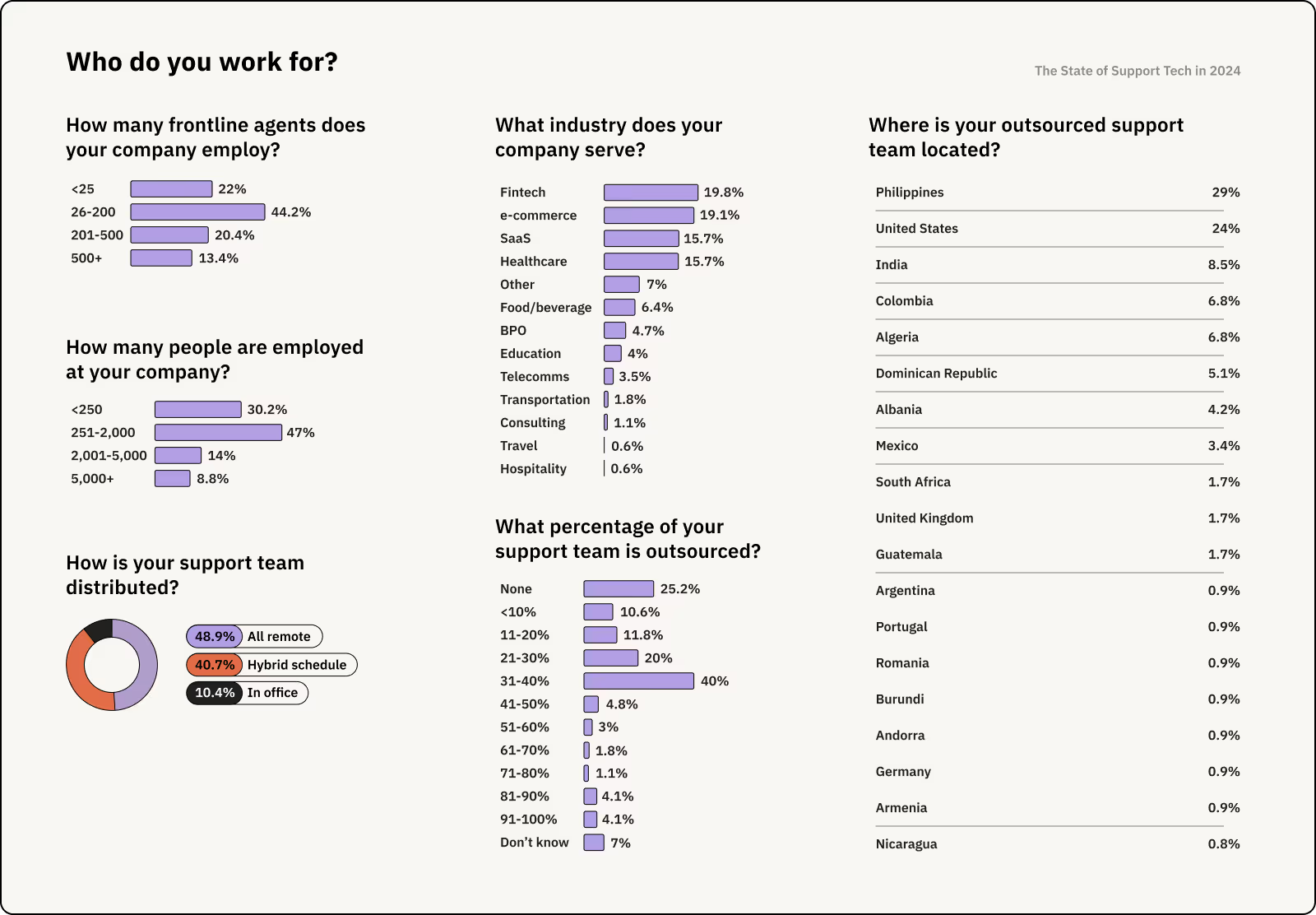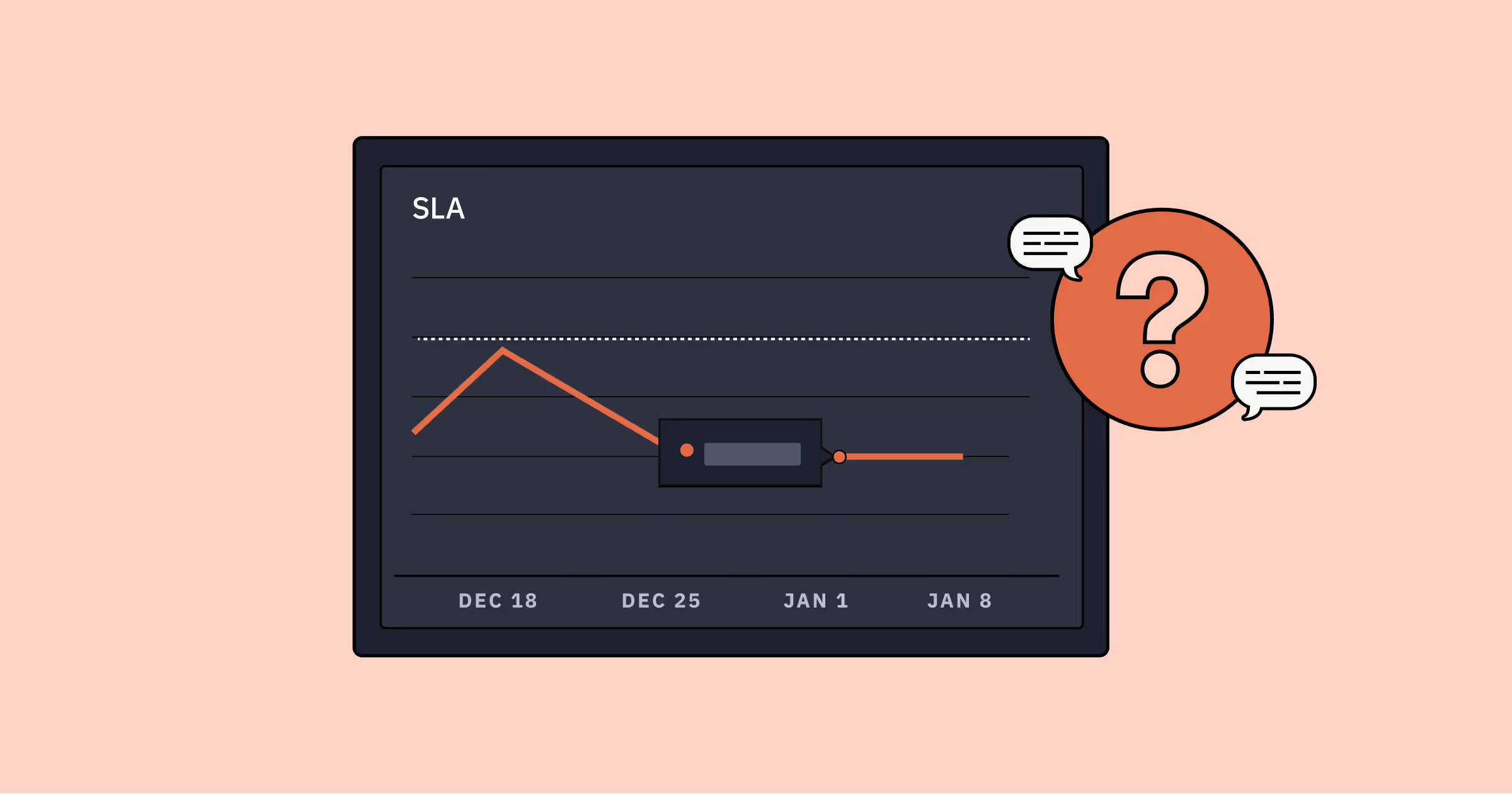The state of support tech in 2024
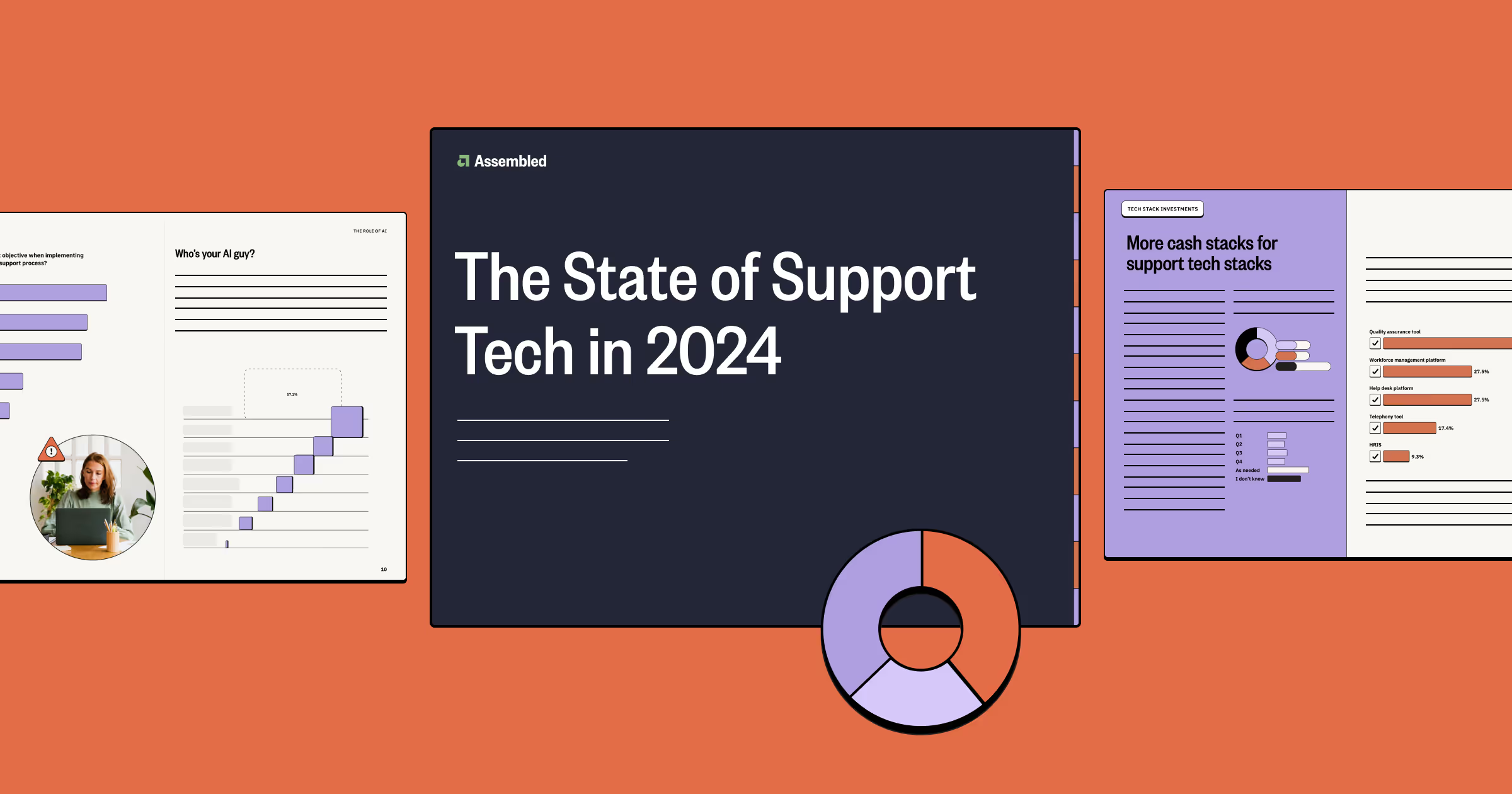
A letter from Assembled’s CEO
The ever-elusive golden tech stack
Is a team only as good as its tools? Or are the tools only as good as the team using them? I don’t have a definitive answer here, as I believe there’s truth in both statements.
But if there’s one thing I can say with certainty, it’s that concerns around ideal tech stacks come up a lot in my conversations with customer support teams. There’s a general sentiment that tech stack choices can result in a hugely positive force multiplier or a wide-reaching, noticeable drag. And with the proliferation of new tools and new categories — as well as the increasing importance of interoperability — these choices have become more challenging.
Some folks are feeling the pressure from their finance departments or leadership teams to consolidate their tech stack. Others are having to answer for why their all-in-one tool is failing to meet the mark. Some are being asked if they can reduce costs by eliminating tools and finding manual workarounds. Others are being told to go out and procure new tools that will multiply the productivity of their existing teams.
In short, no two tech stack challenges look exactly alike. And similarly, no one tech stack lineup will meet every customer support team’s unique needs. Ultimately, getting it right depends on a host of factors — including the level of partnership you receive from your vendors, the quality of your various support tools’ integrations, and the reliability of the data you see across platforms.
We recognize the impossible challenge that teams are facing: Find the perfect set of tools that will 100× output but don’t spend a single extra dollar on tools that won’t immediately deliver. That’s why we put this report together — to provide support teams with a data-driven starting point for assembling their ultimate customer support tech stacks.
In the pages that follow, we’ll unpack the biggest tech stack challenges facing support teams today; gauge the overall temperature for tech investments in the coming year; check in on how teams are feeling about AI for customer support; and share survey respondents’ top-rated tools for each category.
So, without further ado, I invite you to dig into the data!
Ryan Wang
Co-founder and CEO @ Assembled
Survey methodology and demographic data
Methodology
We surveyed hundreds of customer support and support operations professionals across more than a dozen industries to ask them about their customer support tech stacks.
Sometimes the tech stack is out of whack
If everyone thought they had the perfect set of tools, we’d have no good reason to compile this survey report. But alas! Tech stack challenges persist.
Sometimes it’s the tool that fails to meet expectations, and other times it’s how the tool interacts (or doesn’t interact) with other tools that causes its stock to plummet. Whatever the case, these challenges create a lot of friction in customer support workflows. That’s bad news for teams that are under pressure to operate at peak efficiency, which, last time we checked, is pretty much every team these days.
Ramp time is money
Getting ramped up on new support tools isn’t always a walk in the park. Sometimes, it’s downright time- and resource-intensive. Almost 52% of respondents say their help desk has the steepest learning curve for new employees. Next in line? Just shy of 38% of respondents say it’s their workforce management platform that throws new hires for a loop.
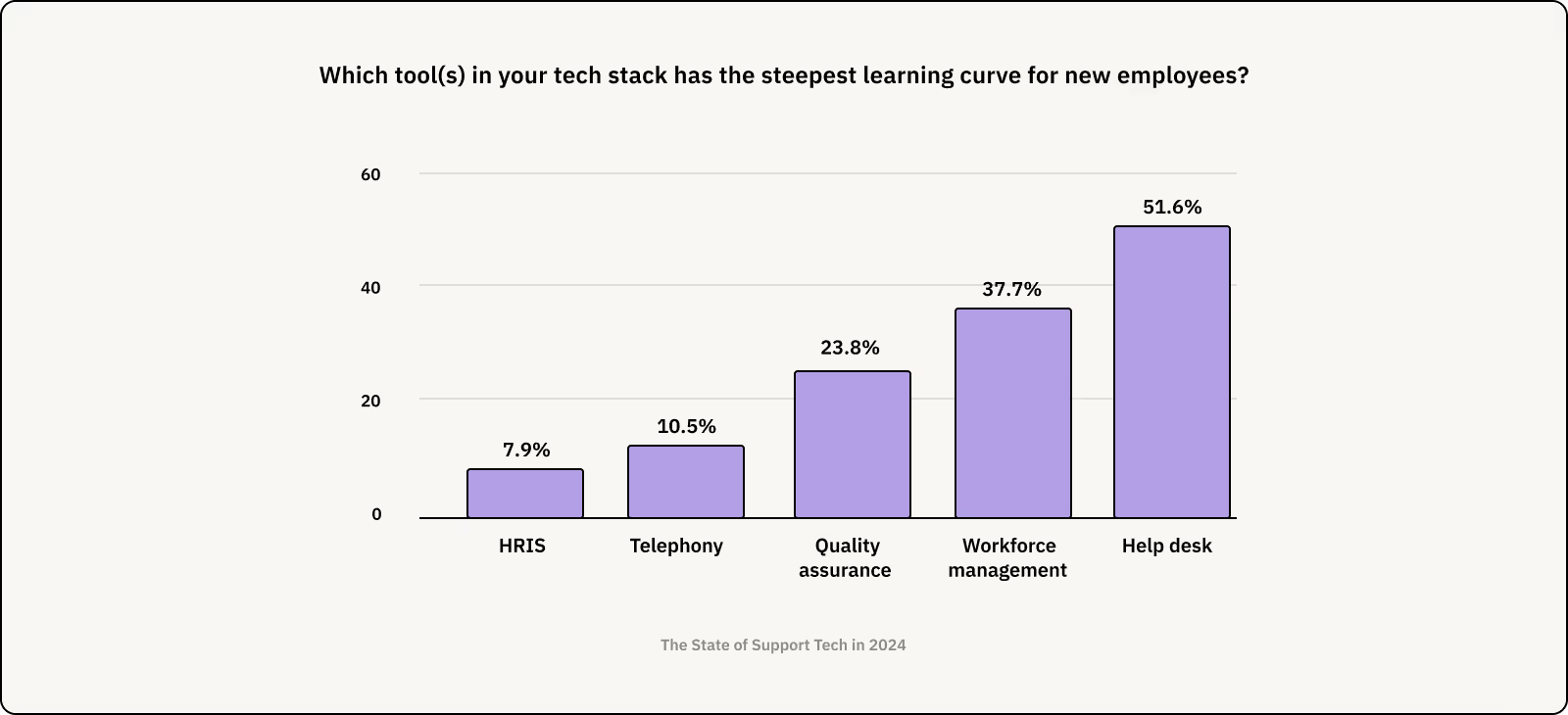
More and more teams are recognizing the value of easy-to-implement, user-friendly solutions. Not only are they faster to deliver ROI, but they zap fewer resources over time and don’t require advanced technical expertise. That last part is key considering the risk that employee turnover and associated loss of institutional knowledge carry.
Integration frustration
In a world where data reliability is key, your CX tools are only as good as the integrations that connect them. Unfortunately, integrations don’t always get the attention they deserve. More than 29% of survey respondents report either weekly or monthly technical issues that stem from weak tech stack integrations.

The main culprits? Perhaps unsurprisingly, it all goes back to data — you know, the currency of this modern-day information era? Nearly 48% of respondents say lack of real-time data gives them grief, while almost 38% say data inaccuracies are the problem.
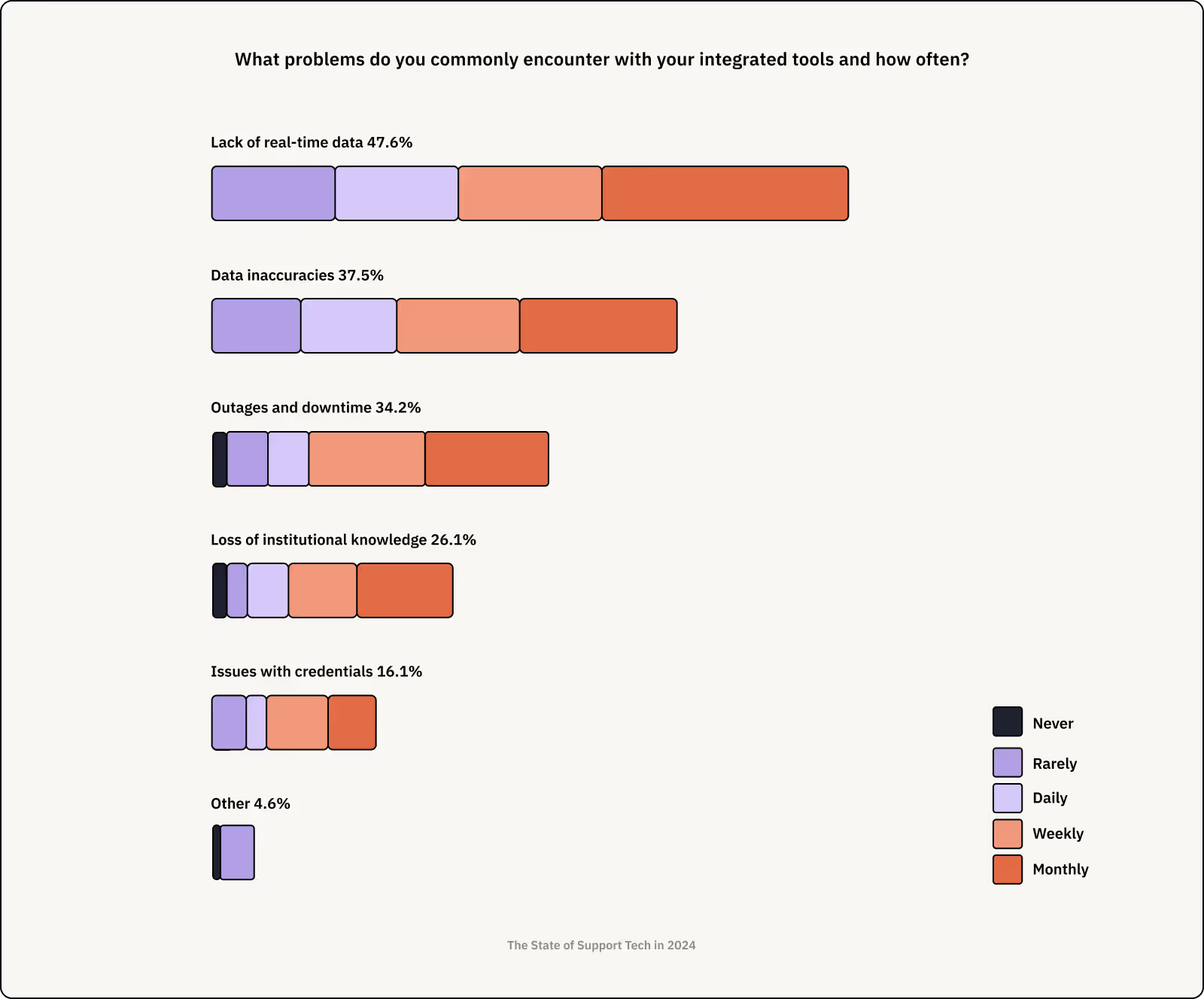
So, which tools have a hard time playing well with others? Turns out the same tools responsible for lengthy ramp times are also responsible for integration woes. 32% of respondents report issues with integrating their help desks while just over 29% say it’s their workforce management platforms that don’t want to play ball.
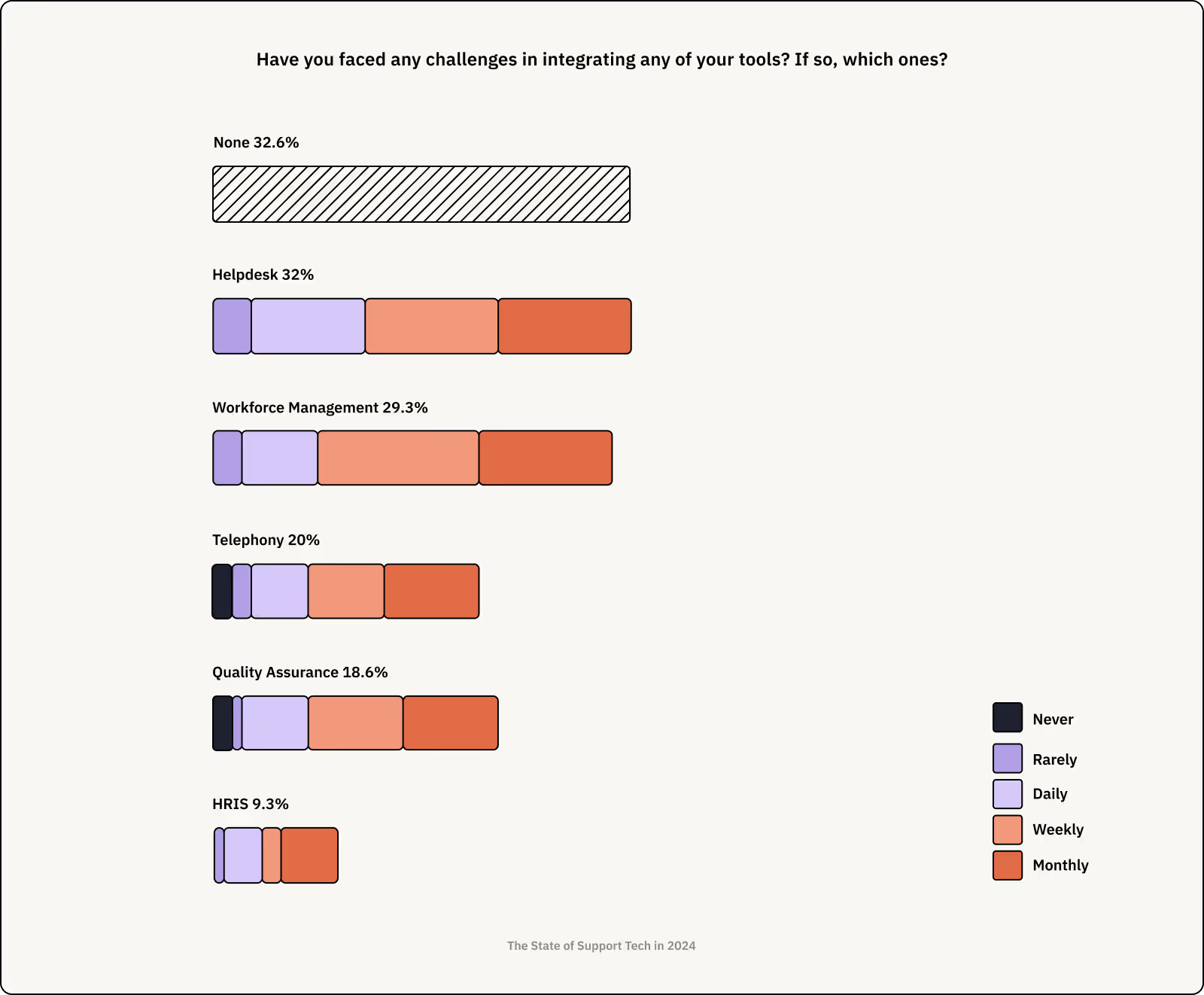
Tech stack investments
More cash stacks for support tech stacks
Between customer support budgets getting slashed and the daunting uncertainty of a bleak economic outlook, new tech investments were somewhat of a touchy subject these past couple years.
But in 2024? Things seem to be looking up. At least 39% of survey respondents say their company is planning to invest in new customer support tools within the next year. And for most companies we surveyed, there’s no set schedule or specific time of the year when these purchasing decisions take place. Nearly 30% of respondents said tech investments are made on an as-needed basis.


Some of those will be net new and some of those will be replacements. In the latter category, more than 46% of respondents are planning to switch to a new quality assurance tool. Help desks and workforce management platforms are tied for second, each with 27.5% of respondents saying it’s time for an upgrade.
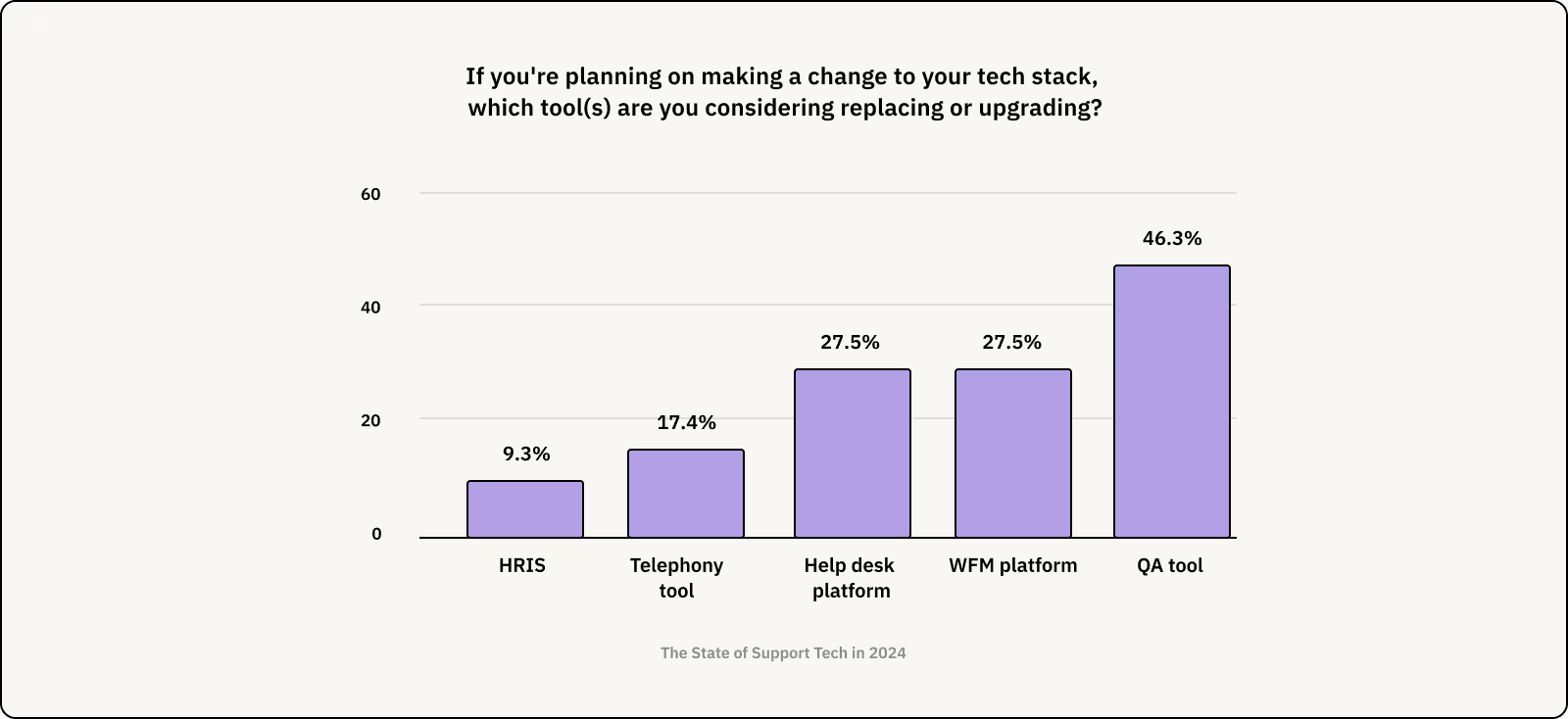
But wait, who’s driving these purchasing decisions? More than 32% of our survey respondents said the customer support department is behind the wheel.
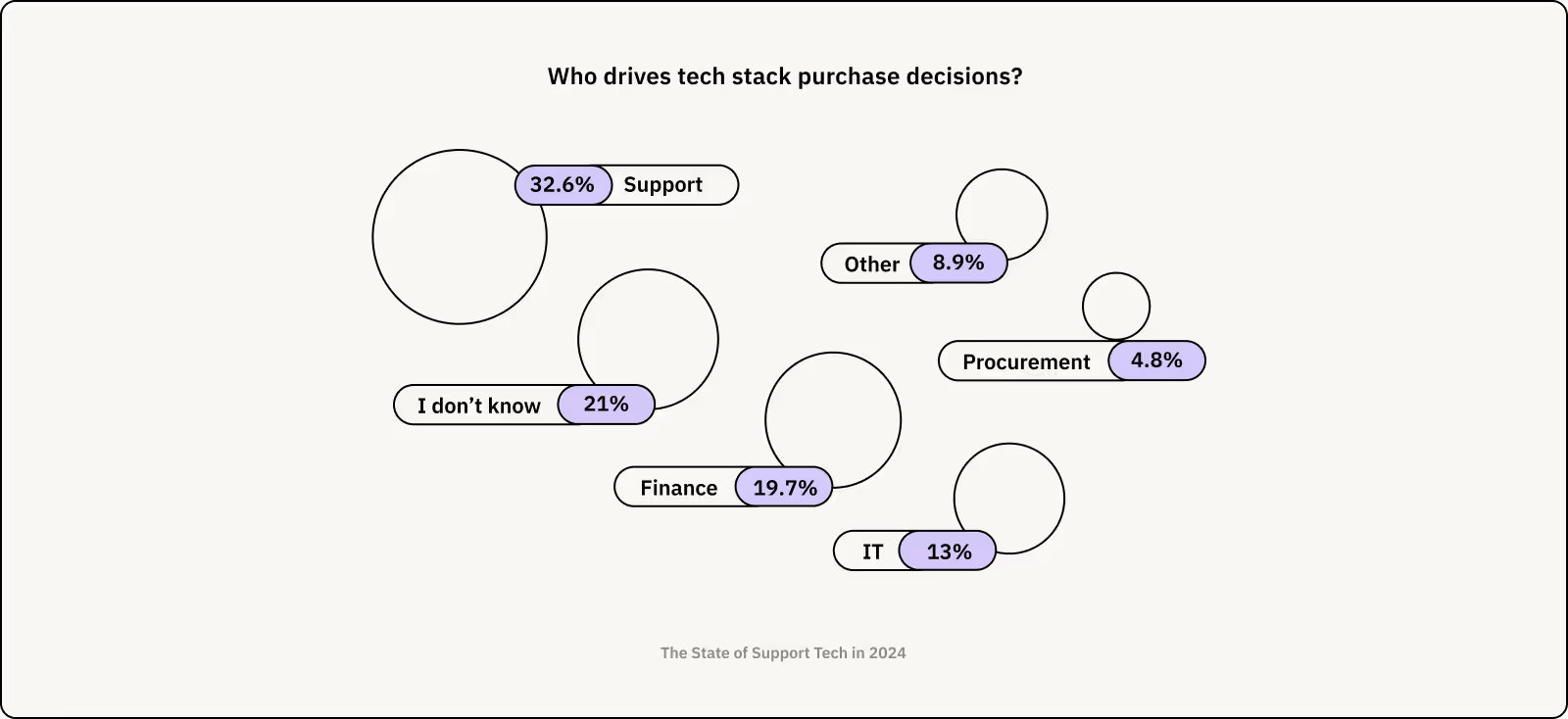
Consolidation station
We know from our conversations with companies of all sizes that the economic uncertainty of these past few years had a lot of folks noodling over the idea of tech stack consolidation. On a scale of 1–5, 35.2% of respondents rated tech stack consolidation a level 4 out of 5 priority.

A word of caution: In many cases, tech stack consolidation isn’t all it’s cracked up to be. What we’ve seen in practice is that no all-in-one solution does everything well — and it’s the teams who fall for the grabby sales pitch that suffer.
Between clunky workflows that require constant intervention and ultimately being forced back to the drawing board to find tools that can actually get the job done, tech stack consolidation can end up being more expensive than working with multiple vendors.
Our two cents? Teams that focus on best-in-class solutions with robust integrations will have less confusion, less frustration, and lower costs in the long run.
The role of AI
Keeping an eye on AI
It wouldn’t be a 2024 tech stack survey report if we didn’t talk about AI.
More than half of survey respondents are all in on the belief that AI will have a significant impact on shaping the future of customer support, but they’ve got their hesitations too.

Among several concerns, the biggest reservation seems to be that AI can’t fully replicate agent work or brand voice. Behind that, the second most cited worry is that customers will get caught in an endless, unhelpful loop with a chatbot (we’ve all been there).
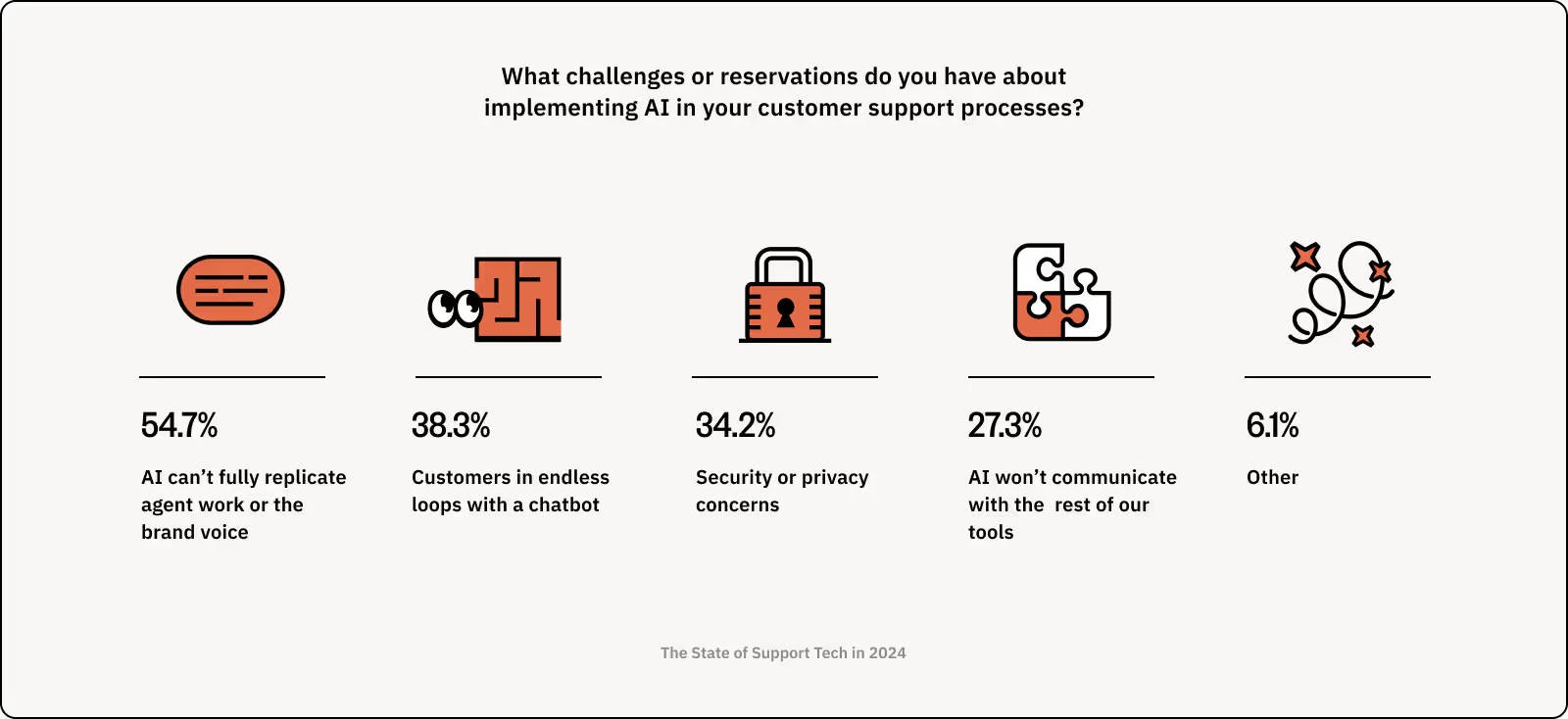
Nearly 23% of survey respondents cited quality control as their number-one AI objective. Ticket triage or categorization and deflection weren’t far behind, with just over 19% of respondents saying that’s where they’re hedging their AI bets.
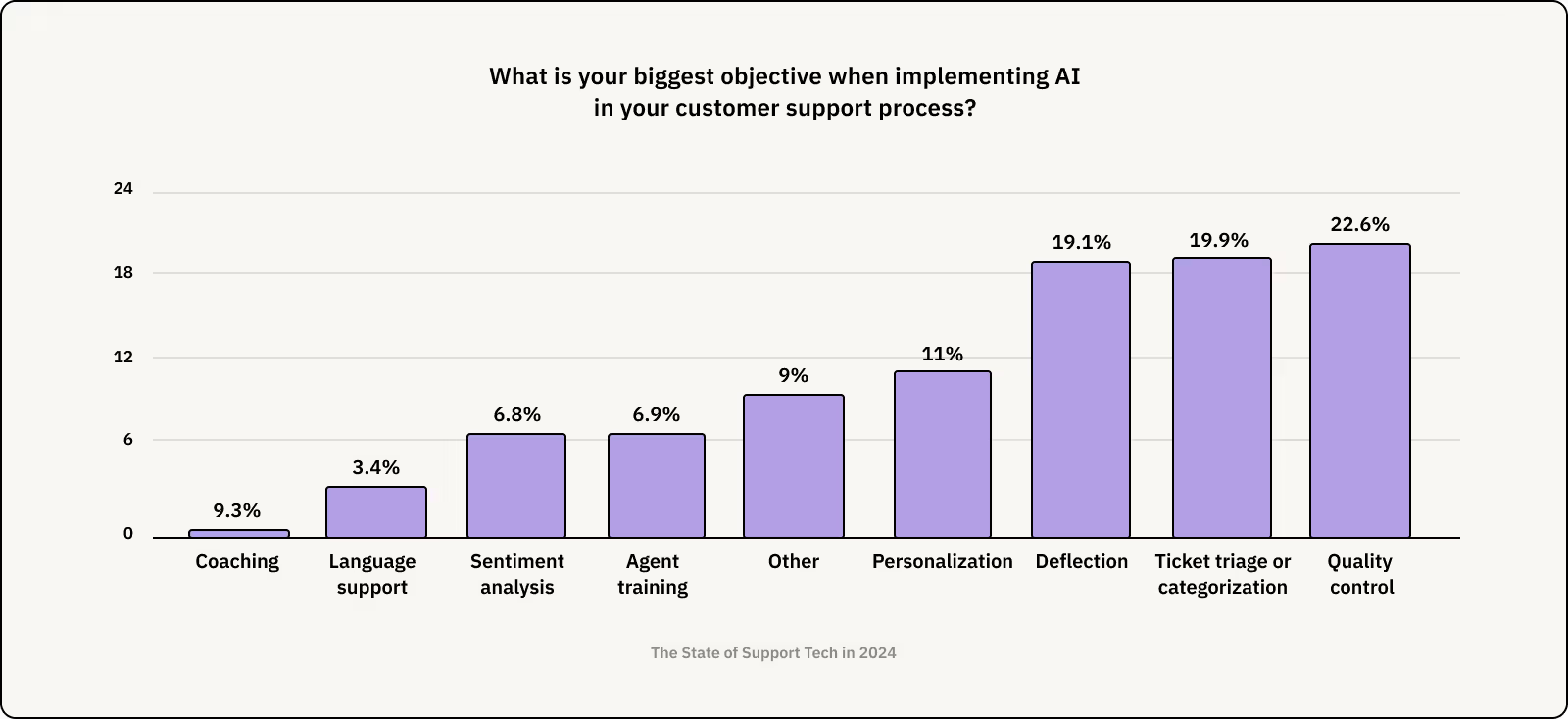
Who’s your AI guy?
We asked companies that are already invested in AI for customer support about what vendors they’re working with. At this point, there doesn’t seem to be a clear market leader. Just over 57% of respondents said their tool wasn’t listed in our survey, while 14.2% said they’re currently using Forethought.
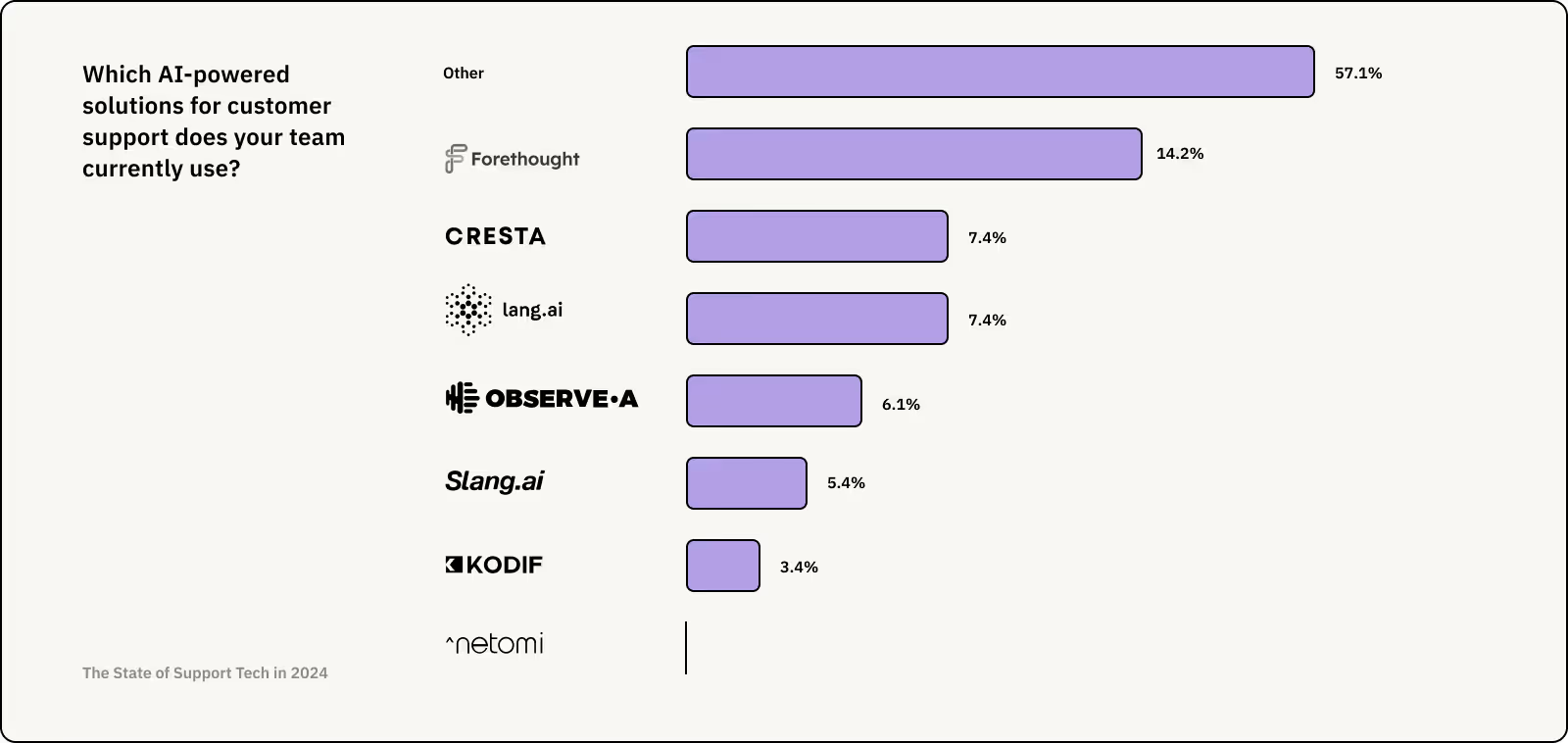
Given the amount of innovation taking place in this already crowded, competitive space, we reckon it’s going to be quite some time before we see a truly standout contender emerge.
Top-rated support tools
Support tools to swipe right on
All dogs are good dogs but not all support tools are good support tools. We asked survey respondents to tell us how they really feel about the main tools in their customer support tech stacks — including their workforce management (WFM) platforms, quality assurance (QA) tools, help desks, and telephony tools.
WFM platforms
All in all, survey respondents feel positively about their WFM platforms. Almost 40% of respondents say their WFM is worthy of a five-star rating.

This probably goes without saying, but survey respondents who rely solely on spreadsheets reported the lowest satisfaction across the board. It’s safe to say that any tool is better than no tool at all.
The winner’s circle
After digging into WFM platform data by provider, it was hard to not separate WFM tools into two categories: modern WFM tools and legacy WFM tools. The dividing line between the two? The emergence of omnichannel — which was brought about in 2010.
WFM platforms created before 2010 have added new features to stay competitive in an omnichannel-first world, but the technology underlying these platforms remains biased toward inbound call center environments. WFM platforms created after 2010 are purpose-built for omnichannel and, as such, are less prone to crufty technology that tends to slow the user and customer experience down.
Top-rated modern WFM platform
Assembled, Playvox, and Tymeshift were all created in the omnichannel era. Assembled earned the highest ratings overall, with almost 47% of respondents who use the platform giving it a perfect 5.
Top-rated legacy WFM platform
NICE, Calabrio, Verint, and Genesys were all created before omnichannel support was a thing. If traditional call center environments are your thing, these are the WFM platforms for you. Just under 45% of NICE users say the platform deserves a five-star rating.
QA tools
On a high level, survey respondents are feeling alright about their QA tools. Just shy of 39% of respondents gave their QA tools a 5 out of 5. That said, QA was the one category on our list to receive the most three-star ratings, with 25.5% of respondents feeling pretty middle of the road when it comes to their QA setup.

The winner’s circle
When evaluating survey data for QA tools by vendor, the results are most striking when broken down by industry.
Top-rated QA tool for SaaS and fintech companies
Nearly 71% of survey respondents who use Klaus for QA rated their tool a perfect 5 — more than 47% of which work in the broader technology sector. Our results show an even split between SaaS and fintech, with 23.53% of respondents each.
Top-rated QA tool for healthcare companies
Just under 61% of EvaluAgent users who responded to our survey gave their tool a five-star rating — 60.61% of which serve the healthcare industry.
Top-rated QA tool for e-commerce companies
Close to 52% of respondents who use MaestroQA say their tool earns a solid 5 out of 5 — almost 39% of which support e-commerce businesses.
Help desks
Zooming out and looking at how satisfied survey respondents are with their help desks on the whole, the help desks are doing okay. 39.86% of respondents give their help desk a 4 out of 5 and 39.7% give theirs a perfect 5.

The winner’s circle
Digging into the data by help desk provider, three clear winners emerge — and, perhaps unsurprisingly, they line up perfectly with the markets they’re intended to support.
Top-rated help desk for enterprise companies
According to our survey, Salesforce Service Cloud is the top-rated help desk for companies with 1,000 employees or more. Interestingly, respondent seniority level does not appear to be a factor. Service Cloud received a high percentage of five-star ratings from associates, managers, and directors alike. Support operations folks were the biggest Service Cloud cheerleaders, accounting for just shy of 30% of five-star ratings across all job functions surveyed.
Top-rated help desk for mid-market companies
For companies with 100–999 employees, our survey shows that Zendesk is the top-rated help desk. Survey respondents at the managerial level are the biggest Zendesk fans, with 20% of managers giving the help desk a perfect 5.
Top-rated help desk for small- and medium-sized companies
Last but certainly not least, Intercom came in as the top-rated help desk for companies with fewer than 100 employees. Workforce managers and support operations folks doled out the most five-star ratings, with nearly 30% of each job function saying yes to the help desk.
Telephony tools
Of all the support tech we asked survey respondents to rate, telephony tools had the highest instance of five-star ratings overall. Almost 46% of respondents give their telephony tool a perfect 5.

The winner’s circle
When looking at our survey respondents’ top-rated telephony tools, we discovered one all-around favorite and a couple of interesting relationships between job function and telephony tool of choice.
Top-rated telephony tool across all job functions
More than 83% of Zoom Contact Center users give this telephony tool a five-star review. This is a fan favorite across the board — regardless of job function, seniority level, or years of experience.
Top-rated telephony tool by workforce managers
A very close second, almost 82% of Five9 users say the tool earns a 5 out of 5 — 28.26% of which are workforce managers. Five9 also appears to be overwhelmingly favored by remote teams, with 63% of Five9 users saying that’s how their team is distributed.
Top-rated telephony by support operations professionals
Nearly 56% of Talkdesk users say their telephony tool gets a perfect 5 — 41.67% of which are support operations professionals. Talkdesk appears to be the preferred choice for hybrid teams, with 67% of Talkdesk users saying that’s how their team collaborates.
